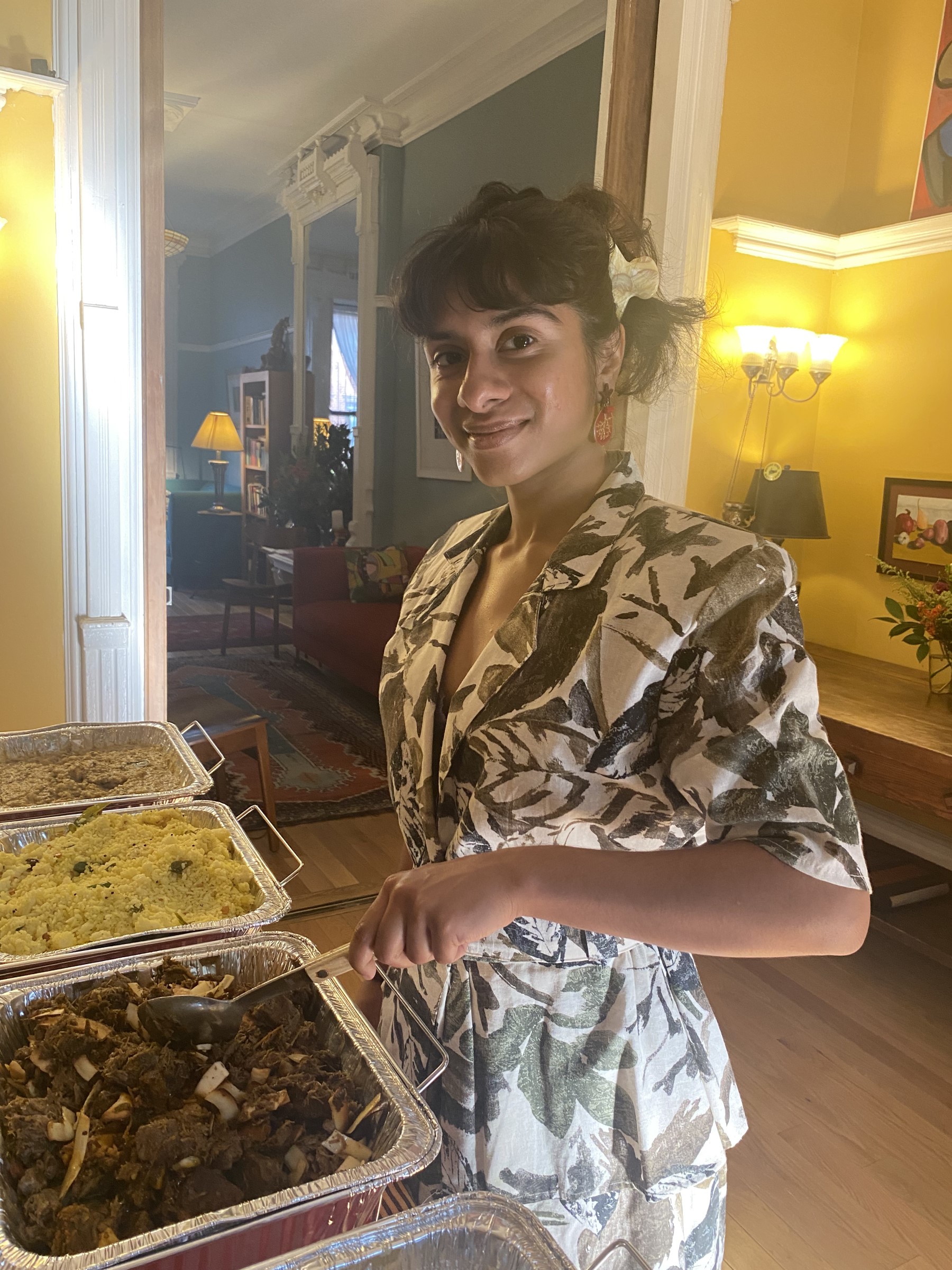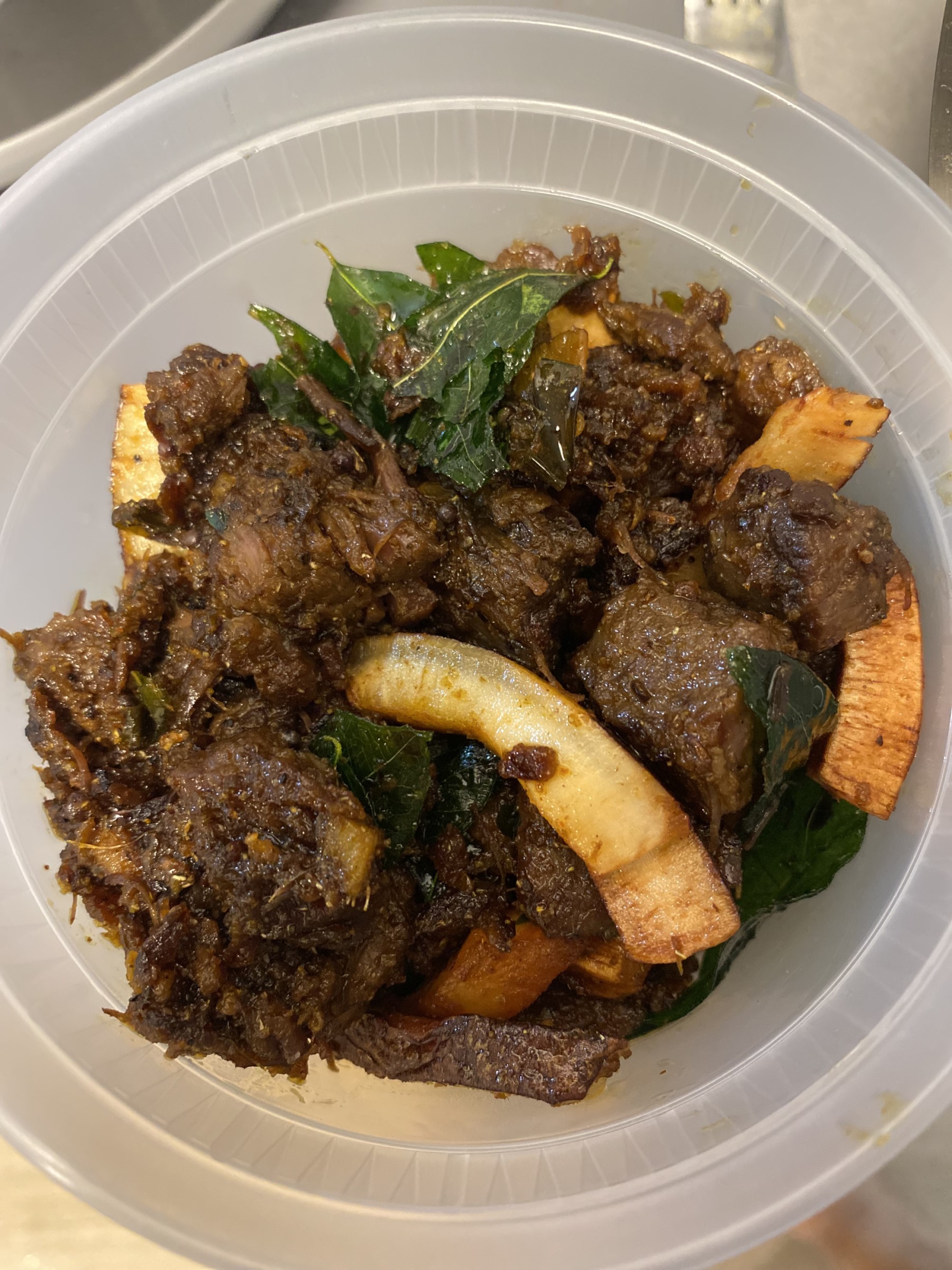(October 6, 2022) Ten days ago, a post by writer Amitav Ghosh, who is quite the foodie, appeared on my Instagram feed. It was a glowing recommendation, along with a photograph, of a young chef, with Ghosh writing, “Great spread of pre-wedding Malayali food by Sarah Thomas and Hunter Jamison… If you are in the NYC area and longing for some spicy Malayali food.” One assumes this would be the work of a veteran chef, Ghosh is, after all, one of the most celebrated names in the literary world. It was, however, a very youthful young woman who appeared on screen for the interview with Global Indian. “I’m 23 years old,” Chef Sarah Thomas says. “I began my catering business in January 2021.” Today, the young Global Indian works 20 hours on some days, making up to 50 dishes at a time.
Growing up in New Jersey, where her parents moved from Kerala, Sarah’s diet always comprised of home-cooked Malayali staples. “My mom would wake up at 5 am to cook for the whole family every day. It would make me angry then because it was distracting, I couldn’t study and my clothes would smell. I never liked it.” Soon after college, however, when she moved away from home, she found herself craving her mother’s cooking and simply couldn’t find a suitable substitute. “What is available is either fusion or very high-end. The simple, traditional dishes were impossible to find. I simply wasn’t tasting what I was getting at home,” she says. Sarah decided to try her hand at it, setting up ‘Sugar Dosa’ on Shef, an online platform for people to order authentic, homemade meals made by local, certified chefs from around the world.

Straddling two worlds
Although her parents remained more or less rooted in their native culture, Sarah felt quite separated from it. “I’m only Malayali ethnically, I tell people that too. I don’t speak the language as well as I should.” She was a serious teen, studying medicine as so many Indian kids in the US do. Sarah realised soon enough that it wasn’t what she wanted to do with her life and decided she would much rather teach yoga. “After I studied and did all my exams, I realised what I was doing didn’t feel authentic to me. My parents worked hard to bring me here and the idea behind doing so was to see a different way of life – that’s part of being American too.” So, she turned to her decade-long association with yoga. “My father is a yoga teacher, he had studied at the Sivananda Institute. I learned from him when I was young and we would also teach together,” she says.
In college, much to the alarm of her traditional parents, she chose a course in acting and creative writing. After that, she moved to NYC, signing up as a teacher with a yoga studio and working on writing short stories as well, in which she talked about life as an Indian growing up in America. “I found I didn’t like the Western style of yoga, though. Here, the fear of cultural appropriation is a big deal, and yoga is seen as just a workout. Writing is also extremely competitive.” Her three-year stint at the yoga studio ended unpleasantly when it became involved in a tax that “ruined the perception of yoga.”
Food from home


Sarah’s Beef Ularthiyathu
In 2020, when she created a platform for Malayali food on Shef, there was huge interest almost immediately. “I was the only one there making appams and egg curry,” she smiles. She makes the batter by hand, substituting toddy, which she simply cannot get in the US, with yeast. “It works just as well,” she says. The spice mixes are also hand-ground and she travels to New Jersey, which is home to a large Indian diaspora and major department stores that specialise in Indian ingredients, to buy what she needs. The Malabar Chicken Curry, appam and egg curry, and the famous Kerala beef fry (for private customers) are all in high demand.
Amitav Ghosh was among those who found her online. He ordered once and then again, after which he messaged Sarah, asking her if she would be willing to cater an event. “I didn’t know it was the day of his son’s wedding, he told me it was for a wedding party. I ended up catering this big meal for them right before they got married. It was also my first huge party.” As she found her feet – Sarah is now expanding into a professional kitchen – she found, through yoga, writing, and cooking, a way to “tell my story without having to do anything out of the way. When I catered Mr. Ghosh’s event, people already knew what I did and where I came from.”
View this post on Instagram
What lies ahead
Sarah now plans to set up her own ‘Malayali cafe’ in the Lower East End, with doubles as a yoga studio. “That way, I can do both. To me, cooking is a form of yoga too. Here, yoga is a physical activity and is rarely paired with mindful practice, meditation, or the correct ways of eating,” she says. Having studied meditation from former experts who learned from Osho back in the 1970s, Sarah’s method of teaching yoga is to prepare the body for meditation.
“All of it is coming together for me,” she says, as she concludes. “There are more South Indians here than ever before and I’m more emboldened now to share what I do and put a plate in front of someone. A lot of people come from India to New York and tell me they haven’t eaten this kind of Malayali food for years. I’m happy doing this, instead of taking a more traditional path.”
Follow Sarah’s Sugar Dosa on Instagram

